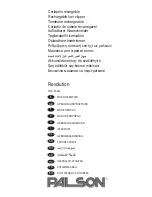
38
EN
Work with the garden
chipper
Adopt working posture on the side or behind the
appliance.
Longer material protruding from the unit could be
shot out of the unit when it is pulled in with knives!
Keep the safe distance!
Never put your hand into the filling and output
openings.
Keep your face and body at a sufficient distance
from the filling opening.
Never put hands or any other parts of body and
clothing in the proximity of the filling and output
openings or other movable parts.
Check before putting the machine into operation –
whether there are not any residues from chipping in
the filling funnel – whether the collection basket is
locked in the machine.
Never tilt the unit while its motor is running.
It is necessary to ensure at filling that any metallic
objects, stones, bottles or any other unworkable
items cannot get in the hopper.
When using the chipper, it is necessary to take into
consideration the quality and humidity of chipped
material; chipped material should be pulled out
partially from time to time in order to alleviate unit
loading.
When any foreign objects get into the hopper or
the unit starts to emit unusual noise or to vibrate,
turn it off immediately and let it stop completely.
Before restarting the appliance, disconnect the
power supply cable from the mains and perform the
following steps:
− check the unit for damage
− replace or repair damaged parts
− inspect the appliance and tighten any loosened
parts.
You may not repair the appliance if you are not
authorized to do so.
What can be chipped?
Yes:
• Branches of all species up to the specified diameter
in dependence upon wood type and freshness
• Withered, moist, already for several days dumped
garden waste only alternately with branches
No:
• Glass, metallic parts, plastics, plastic bags, stones,
textile, roots together with soil, etc.
• Waste without solid consistency such as kitchen
waste
Filling side
Instructions for chipping:
Fill the material to be
chipped into the hopper
filling opening always from
the righthand side.
Chipping procedure
Use a wooden rod for
the removal of blocked
objects from the hopper or ejection opening.
Chip branches, sticks and wood pieces shortly after
cutting – if material dries up, it becomes very hard
and the diameters specified for chipping are to be
reduced.
Branches with multiple sprouts may be chipped only
after removal of side sprouts.
Processing of material with high water contents
susceptible to sticking - chip this material alternately
with wooden material so as to eliminate the unit
jamming.
Do not allow blocking of the ejection opening with
chipped material. This may result in reverse material
shooting in the input opening. For that reason, empty
the collection basket regularly.
If the inlet or outlet openings become blocked, it is
necessary to clean them. For this purpose, turn the
unit off at first and disconnect it by unplugging the
mains plug from the socket.
Make sure that the corresponding maximum diame-
ter of chipped branches is observed during chipping
(see "Technical Data"). This diameter may be redu-
ced in dependence upon type and water contents of
fresh branches.
The cylindrical cutter of the appliance pulls the
chipped material in automatically and slow operation
of the cutter does not cause jerky material movement
(it "does not kick back").
Automatic turning direction change: In the case of
sudden blocking of the appliance the direction of the
cutter rotation may be reversed and chipped material
is pushed back.
− Turn the appliance off.
− Wait until the cylindrical cutter stops completely.
− Start the appliance again and use material which is
easier to be processed.
In the case of overloading, the motor protective
switch trips automatically
– start the chipper again using the reset button after
approximately 5 minutes,
– when the appliance cannot be started after this peri-
od, see the section "Potential Faults".







































